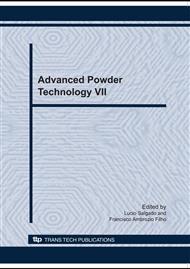p.363
p.370
p.379
p.385
p.391
p.399
p.405
p.413
p.419
Porous 3-D Titanium Substrates Obtained by Powder Metallurgy for Nanodiamond Film Growth
Abstract:
Power metallurgy has been used to produce compacts by two different routes. In this work, porous three-dimensional (3-D) substrates were prepared by the conventional pre-forms sintering method. Titanium powders were uniaxial pressed at 110 Mpa and vacuum (1 x 10-5 Pa) sintered at 1500 K. Another group of substrates were obtained by the space holder technique. Irregular shaped carbamide particles (210 – 250 m diameters) were mixed to Ti powders, pressed and sintered. Before the sintering the compacts were heated at 470 K for 3 h to eliminate the spacing holder agent. Nanodiamond films were grown by hot-filament chemical vapor deposition technique on such substrates at 870 K from a mixture of Ar/H2 (80%-18,5%) respectively and a solid carbon source. SEM images show the substrates totally covered by a nanodiamond film including deeper planes. Raman Spectra confirm the good quality of the nanodiamond film.
Info:
Periodical:
Pages:
391-396
Citation:
Online since:
October 2010
Keywords:
Price:
Сopyright:
© 2010 Trans Tech Publications Ltd. All Rights Reserved
Share:
Citation:


